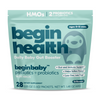HMOs for Kids Explained
share this article

Human Milk Oligosaccharides—better known as HMOs—are one of the most exciting breakthroughs in pediatric nutrition in recent years. Found naturally in breast milk, these complex sugars play a powerful role in supporting a baby’s developing gut and immune system.
But what are HMOs, exactly? Why are they showing up in supplements and formulas? And are they helpful for toddlers and older kids, too?
Let’s break it down.
What Are HMOs?
HMOs (Human Milk Oligosaccharides) are specialized prebiotic carbohydrates found in human breast milk. They are the third most abundant solid component of breast milk after lactose and fats—yet babies can't digest them directly.
Instead, HMOs serve as food for specific beneficial bacteria in the gut, especially Bifidobacterium longum subsp. infantis(B. infantis), helping shape a healthy microbial community in the early days of life.
There are over 200 unique types of HMOs found in breast milk, each with slightly different structures and functions. While most infant formulas contain only one or two types, such as 2'-fucosyllactose (2'-FL), these have been shown to offer many of the same benefits as those found in breast milk.
What Do HMOs Do?
Though indigestible to the human body, HMOs are biologically active and serve several important roles:
-
Feed beneficial gut bacteria (especially bifidobacteria)
-
Support the development of the immune system
-
Strengthen the gut barrier to protect against pathogens
-
Reduce inflammation in the gut
-
Block harmful bacteria from attaching to intestinal cells
Together, these actions help reduce the risk of digestive issues, allergies, and infections, especially in early life.
Are HMOs Just for Infants?
While HMOs are naturally present in breast milk, emerging research suggests they can also benefit toddlers and older kids—especially those who were formula-fed, born by C-section, exposed to antibiotics, or have gut imbalances.
After infancy, it becomes harder to get prebiotic support from diet alone, especially if a kiddo is a picky eater or low in fiber. Supplementing with HMOs may help:
-
Support regular bowel movements
-
Promote a healthy gut microbiome
-
Enhance immune function in daycare and school-age settings
-
Improve stool consistency and gut comfort
In fact, prebiotic HMOs like 2’-FL have been shown to be safe and well-tolerated in both infants and young children when added to formula or food.¹
Where Can Kids Get HMOs?
For breastfed infants, HMOs are naturally present in breast milk. For others, there are now high-quality HMO supplements designed specifically for babies and kids.
At Begin Health, both Beginbaby Prebiotic + Probiotics (for infants) and Growing Up Prebiotics (for toddlers and kids) contain 2'-FL HMO—the most researched HMO for gut and immune support.
-
Beginbaby is formulated for babies ages 0 to 12 months old.
-
Growing Up Prebiotics is for kids ages 1 year and up.
These supplements help babies and kids develop their growing microbiome from early infancy and beyond.
Summary
HMOs are a powerful, natural way to support a kid’s gut and immune health from infancy through early childhood. HMOs help feed the good bacteria that build a strong foundation for lifelong health.
















